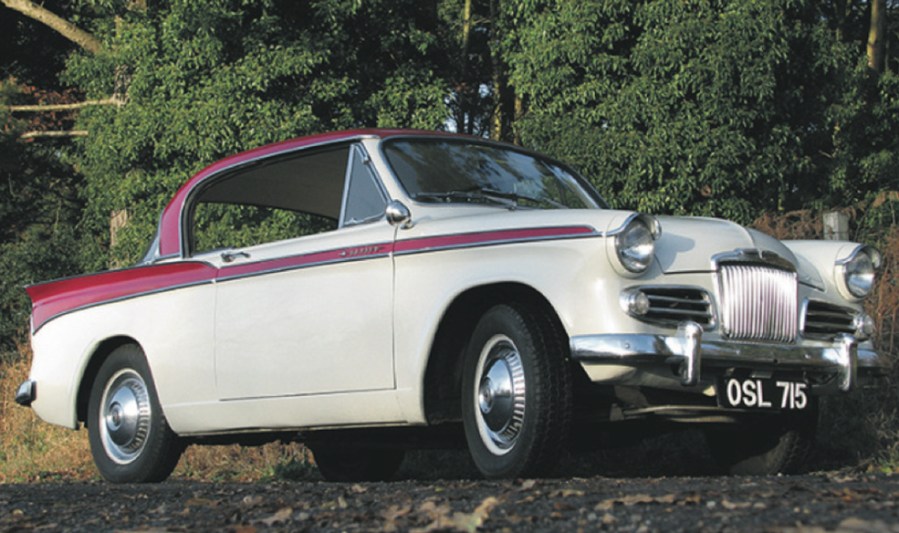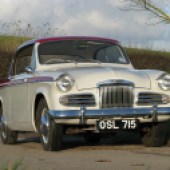Offering a mix of American glamour, British sporting pedigree and a famous badge, the Sunbeam Rapier was a rakish enthusiasts’ choice in the 1960s and still makes a great classic today
When it comes to sporty, glamorous coupes based on relatively humdrum family saloons, history often seems to start with the Ford Capri. Certainly the aspirational, macho Ford casts a long shadow, but it was not a new idea – arguably the Rootes group got there first with the Sunbeam Rapier. Since the Rootes brothers assemble their car-building empire in the 1930s they had been firm believers in badge engineering, platform sharing, brand strategies and other techniques more associated with the modern car industry in order to make their assets go as far as possible.
Therefore it was inevitable that there would be a Sunbeam version of Rootes’ new mid-size platform of the mid-1950s (codenamed ‘Audax’). Of course the basic Hillman Minx made up the majority of sales and production, but the Minx was only available as a four-door saloon and its reputation was as a solid, long-lived and practical car but not a particularly glamorous one. Which was where the Rapier came in – in fact it came in first, since it was the first ‘Audax’ car to go into production.
Built as a two-door saloon (with pillarless doors and side windows and a panoramic rear screen, so it was often described as a coupe) and with striking two-tone paintwork separated by a chrome slash along the flanks, the Sunbeam Rapier looked the part. Although the Audax range’s styling is frequently credited to the famous American industrial designer Raymond Loewy, his studio actually only had a consulting agreement with Rootes and the bulk of the work was done in-house at Rootes. That said, the Loewy influence was clear across the range, which bore a strong resemblance to the cars penned by Loewy for Studebaker – the Commander and the Speedster in the case of the Rapier.
It wasn’t entirely style without substance – the engine was the same 1.3-litre unit that was used in the Minx, but with a higher compression ratio, larger carburettor and free-flow manifolds. This was quickly improved to twin Zenith carbs to make 67bhp at a heady 5000rpm, making it a significantly brisker car than the 48bhp Minx. In a Britain without motorways, the Rapier’s top speed of 86mph was more than in keeping with its badge. It was also well-equipped, with a four-speed column change gearbox with overdrive, a full suite of instruments and leather upholstery as standard.
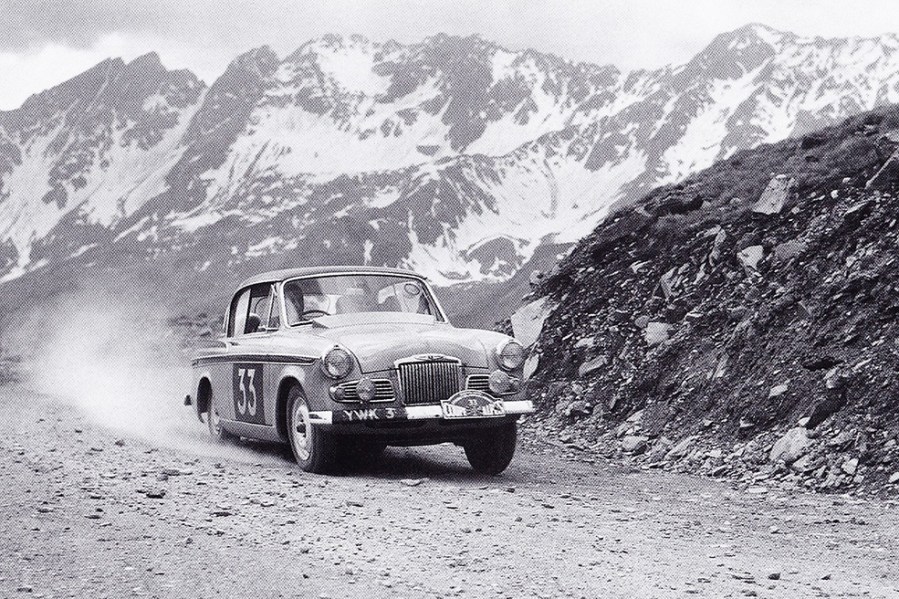
Another American influence on Rootes was the practice of making frequent (often annual) tweaks to its cars – usually alternating between mechanical upgrades and cosmetic changes – to generate continual publicity and entice existing owners to trade in. The full scope of the changes is detailed in the timeline below, but the major alterations are the introduction of a convertible option and the switch to a standard floor-mounted gear lever with the Series II Sunbeam Rapier in 1958, front disc brakes on the Series III in 1959 (the Series III is widely considered the ‘sweet spot’ for the Rapier) and a significant facelift and mechanical modernisation on the Series IV in 1963.
By then the Rapier’s blade had dulled somewhat. The Mini Cooper, and Rootes’ own Hillman Imp, had introduced a new sort of accessible sports saloon to the market. The Imp became Rootes’ competition car of choice and the Sunbeam version, the Stiletto, would apply the same sort of spirit to this new market. Otherwise, modern executive cars like the Triumph 2000 and souped-up saloons like the Ford Cortina GT were all providing more modern and fashionable versions of what had originally made the Rapier so appealing. Sales declined significantly in the late 1960s, but not enough to kill of the model entirely – in 1967 the Audax Rapier was replaced by the striking fastback Rapier on the new ‘Arrow’ platform.
But that package of style, comfort, performance and pedigree with mass-market building blocks makes the Rapier an appealing classic today. They are rare cars – less than 70,000 were built in total and production never exceeded 7000 per year (and dipped below 3000 in the latter parts of the model’s life) and like all Rootes products have not enjoyed the widespread enthusiasm or parts support afforded to some other British cars of the same era. Which makes it all the more vital to be armed with good buying advice if you want to experience the Rapier at its best.
Bodywork
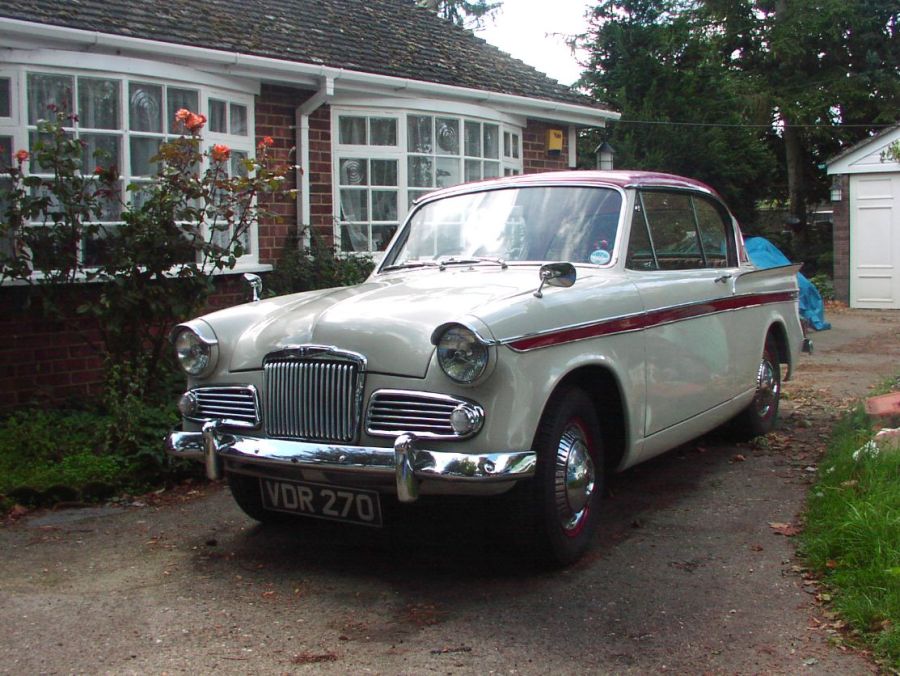
Rapiers, like the rest of the Audax range, have few specific or unusual rot spots, so the advice for checking the body and structure is pretty generic. But where and when they do rust, they can do so with alacrity. Later cars (post-1962 or so) are generally worse for rust than the earlier ones, but it’s not a huge difference. Much of the bodywork is Rapier-specific, which given the model’s rarity now makes putting right any serious corrosion in the panels tricky. The Sunbeam Rapier Owners Club runs a scheme to source, store and sell parts (as well as being a font of advice and experience) so membership would be a good investment even at the buying stage. In general it is much better to buy on condition than to box yourself into buying a specific variety of Rapier that will incur a lot of time, effort and cost to bring up to scratch.
As to where to look; the one major Audax-specific area of concern is the upper part of the inner front wings, from the top of the headlamps back to the bulkhead. This, and the inner wing at the front running down to the radiator apron, are vulnerable to salt, dirt and water being thrown up by the wheels. In the same area, but lower down, the bulkhead can be rotted out from within by a perished windscreen seal – look at the condition of the seal, then inspect the footwells at the seam where they weld into the bulkhead for signs of rust (or rusty water) and be sure of the solidity of the door hinges. Repairing these areas requires a full body strip-down and a lot of fabrication and welding so basically commits such a car to a complete restoration – walk away if that’s not your plan.
The rest of the advice applies to pretty much every 1950s or 1960s car. Inspect the length of the sills and lift the cabin carpets to check them on their inside face and to look at the condition of the floors. At each corner, check the wheel arches inside and out and the lower parts of the wings – repair sections for these areas are the ones that are available. The sills, arches and lower wings are the only areas on a Rapier where repair panels can be had ‘off the shelf’, so moderate rust here need not be a severe worry so long as the rest of the car is solid and it is priced accordingly.
Door skins rust at the lower parts when the drain holes get blocked (inevitable on all but the most pampered cars), so check for rust bubbles in the paint, reluctantly-winding windows from distorted frames and patches of filler marking previous repairs. Door skins are among the parts that are very hard to source now.
The front suspension is carried on a subframe, so check the solidity of the mounting points for this and all the steering and suspension attachments – they usually last pretty well because of oil leaks from the engine. The hangers for the rear leaf springs are not so fortune, so be sure they are in good condition and the metal around them. While there check the condition of the boot floor.
Convertible Sunbeam Rapiers had two ‘chassis’ frames welded to the underside to make up for the loss of rigidity with no solid roof. Check that these are still solid, and the metal doesn’t show any signs of wrinkling or distortion which indicates that the floors and/or the sills have lost strength.
The roof is unique to the Rapier and this means that while it is not home to any specific rust traps, it needs to be checked. Pay particular attention to the rear window seal (which, if perished, lets water into the rear body structure and the boot) and the disappearing pillarless windows. They should operate smoothly and you don’t want to see, feel or smell evidence of rainwater getting in through badly fitting seals. The winders and the winding mechanism are, unsurprisingly, unique to the Rapier and so need to be in good, functional condition.
Engine and transmission
Rootes cars had a reputation for solid, conventional, no-nonsense mechanical parts and that’s certainly the case with the Rapier. The other good news is that because it’s all shared with either the Minx or the Sunbeam Alpine sports car the supply of parts is very good – a Rapier with a solid body but a tired engine is not too much of a daunting proposition.
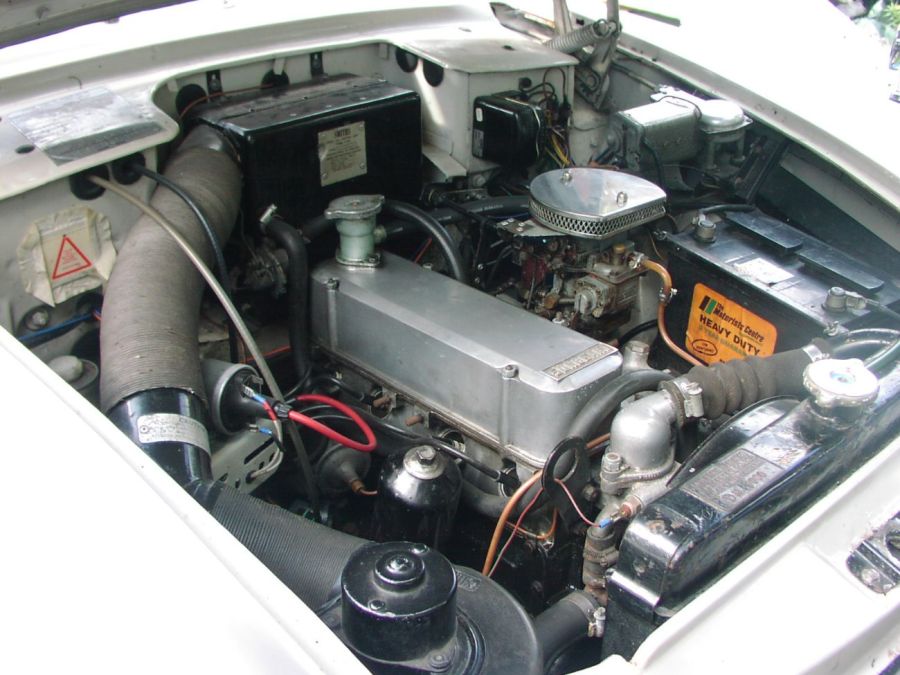
All Sunbeam Rapiers use variants of the same four-cylinder overhead valve engine. Until the very last instalment in the line, the Series V of 1965, it had three main bearings (the Series V had five). Series I and Series II Rapiers were known to hammer their bottom ends when driven hard or when racking up a lot of motorway miles, and this led to the Series III gaining larger bearings and a stiffer crank. Rapiers all generally cover fewer (and gentler) miles and receive better care than they did in the early 1960s, so these differences shouldn’t really be a concern, but if looking at an earlier car just be sure to check the oil pressure gauge – a healthy engine will show at least 20psi at a hot idle and 45psi or more at speed. On all engines check that the pressure rises briskly after starting and listen for knocks or rumbles from the bottom end – or, more accurately, their absence.
Later Rapiers with aluminium alloy cylinder heads need regular coolant changes and the coolant to be the proper mix to prevent internal corrosion and clogging, so check the colour and condition of what’s in the radiator. These heads are also more easily warped or damaged by overheating, so check for signs of head gasket failure. The heads are not particularly fragile and head damage or gasket failure is not at all common so long as the engine isn’t run hot. The Sunbeam Rapier was not prone to overheating in British climates so high temperatures indicate sludgy coolant, blocked cooling passages or a degraded radiator.
Rootes transmissions of this period had a reputation for poor metallurgy, leading to common problems such as broken ring gear teeth on the flywheels, chipped teeth on the gearbox cogs and weak synchromesh. This is not so prevalent these days as most surviving cars have been fitted with stronger replacement parts but it needs checking. Damaged ring gears are shown by binding or free-spinning starter motors. Clicking or rattling sounds when pulling away will show damaged first gear cogs – it can happen on other gears but it’s most likely on first – as will reluctant engagement or the gear jumping out of engagement if the throttle is suddenly released.
Worn synchro reveals itself in difficult or crunchy downchanges. On cars with the column shift it may just be slack in the linkage, which can be adjusted out in all but the worst cases. Most Rapiers had synchromesh on the top three gears only, but later all-synchro ones need to have their gearboxes filled with engine oil, not gear oil. Using the wrong oil will degrade the bronze synchro cones, thrust washers and bearing parts, so if you can’t physically check what’s in the gearbox then quiz the owner or seller.
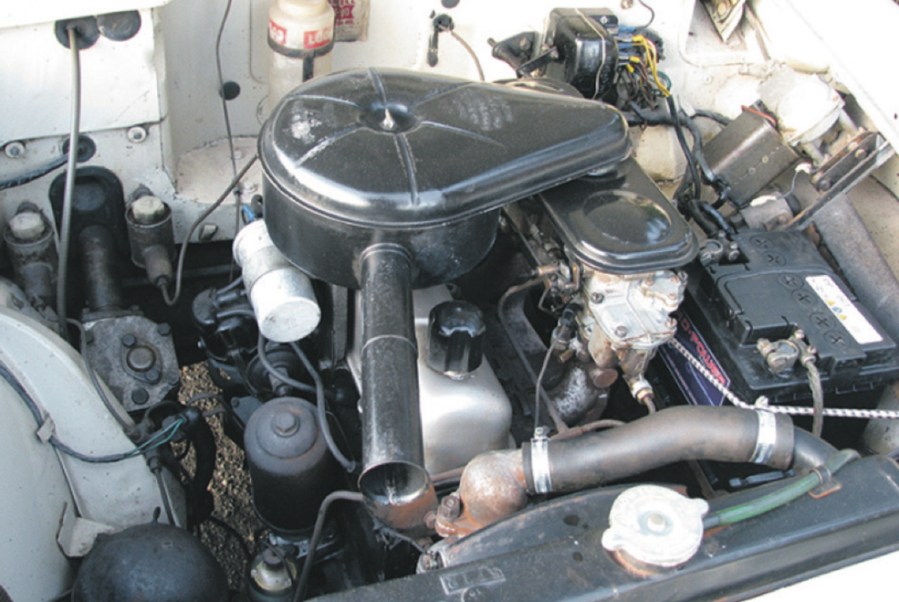
Suspension, steering and brakes
The running gear of the Sunbeam Rapier is, in the Rootes way, conventional and rugged. Wear from age or neglect is the only thing to watch for. The suspension consists of coil springs and double wishbones at the front, and a live axle hung from semi-elliptical leaf springs at the back, with telescopic dampers all-round. Do the ‘bounce test’ to see if the dampers are still good, and if they’re not they’re industry standard parts so new ones can be procured easily. The rear leaf springs sag with age, so check that the spring hasn’t gone completely flat and that the shackle isn’t knocking against the underside of the body (look for missing paint or dents in the metal).
Early cars had a good number of grease fittings and owners were expected to dedicate Sunday afternoons to sessions with the grease gun at regular intervals – the wishbone trunnions, hub swivel pins, track rod ends, steering idler arm and drag links all have grease points. Check that they show signs of having had grease on them at some vaguely recent point and, as you go, check all these points for excessive slop. The Series IV and V Rapier had ‘sealed for life’ fittings but they still need to be checked.
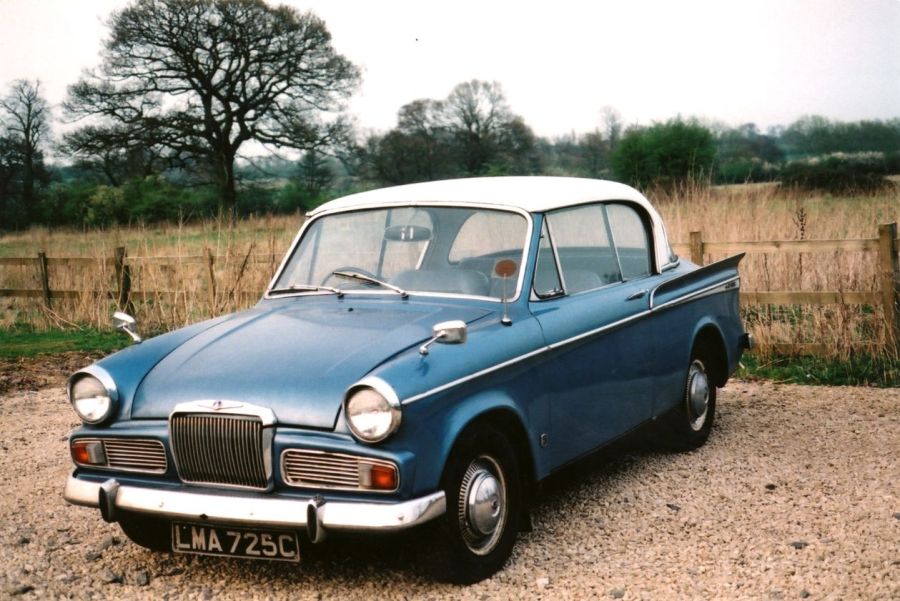
The original Series I Rapier had a pre-war cam-and-peg steering box which was vague and quickly became vaguer with wear. All others had a much better recirculating ball-type box and many – if not most – Series Is have been retrofitted with it. There will be a certain amount of slack in the steering around the mid-point but you shouldn’t have to saw away at the wheel to maintain course and the car should never wander around the road. Wear in the steering box can be adjusted out up to the point, beyond which the steering becomes tight. That can also be caused by partially seized hub swivels, indicative of inadequate greasing. They can be renewed by a garage with the tools and experience to work on older cars.
Most Rapiers have front disc brakes and rear drums, with the first two Series having drums all-round. Just check the condition and continence of the brake lines – solid and flexible – and check for wetness around the wheels and backplates that point to a leaking wheel cylinder. Make sure the brake fluid is clean and up to the correct level. The handbrake is theoretically self-adjusting on the rear drums but often sticks, especially if the handbrake linkage hasn’t been oiled sufficiently.
Interior, trim and electrics
Along with the bodywork, the interior of the Sunbeam Rapier is one of the big dealmakers or breakers. Much of it is unique to the model, none of it is especially durable and it is all very scarce today. It is also key to the look and appeal of the Rapier, so there’s little point in buying one with a shabby cabin. That especially goes for Series I and II cars with the American-style metal and plastic dash. Some instruments are shared with other Audax cars (especially the Alpine in the later Series) which helps, but you want all the Rapier-specific mouldings – the dashboard, the steering wheel, the door fittings – to be present and correct. The seats, door cards and headlining can be refurbished or reupholstered but it would be on a bespoke basis by a specialist trimmer so would be very costly. New carpet sets are available to order for a few hundred pounds.
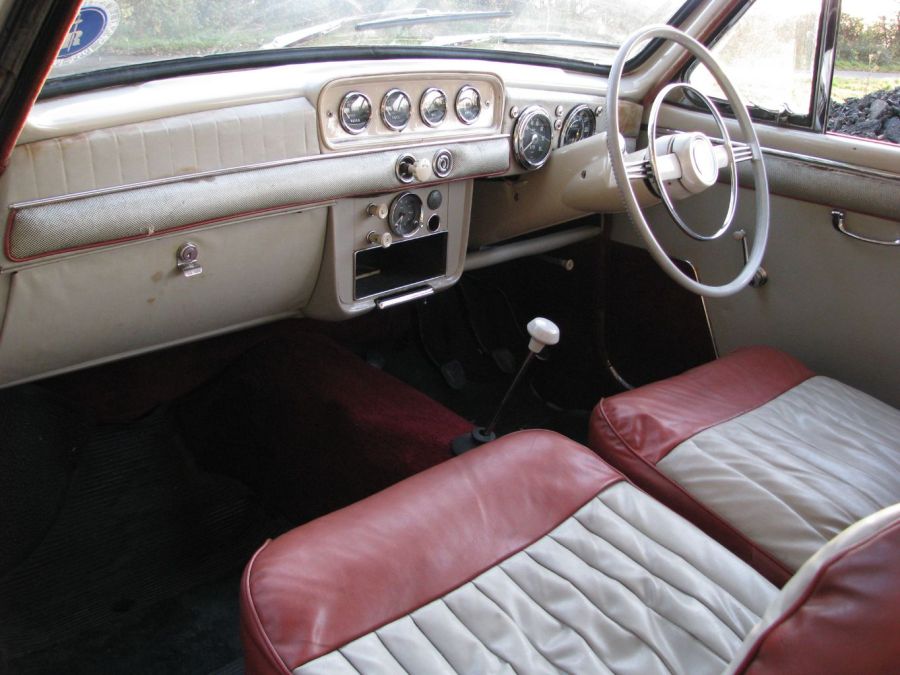
Chrome trim, inside and out, are key to the Rapier’s stylish appearance but replacement parts are very rare due to the low production volumes and because these parts changed from Series to Series every couple of years. You want all the parts to be present and in good condition, otherwise you’re relying on the Owners Club supply or a long time scouring autojumbles and online auctions for that elusive piece.
It is possible to order a new pattern-part hood for a convertible Sunbeam Rapier for just under £600, so it’s not necessarily a dealbreaker if a convertible has a tatty top.
The electrical system is very simple and straightforward – be aware that all Rapiers except the Series V are positive earth. Just check that the wiring loom is in good condition, that there aren’t any awful ‘bodges’, that the earthing points for the lamps and the fusebox are sound and that the switches all operate correctly. This is especially the case for early cars without the walnut dash as these items are particularly scarce.
Sunbeam Rapier: our verdict
The Sunbeam Rapier is one of those cars that seems perfectly formed to be a classic – it oozes style and charm of the era, has a period sporting pedigree, goes well enough to keep pace with modern road conditions and uses familiar and simple mechanical parts that are still widely available. The Rapier was something special in its day, and it still is in the 21st century.
Prices do not really reflect that – all Rootes cars seem to be badly undervalued when compared to equivalent competitors that, objectively, are not significantly superior and are often much more common. There is not a huge difference in values between the different Series since what they generally gain in performance, sophistication and equipment as they progress they lose in rarity and 1950s Loewy-style charm. Convertibles do not carry as much of a premium as you might expect – only 10-15 per cent over an equivalent hard top.
In terms of numbers, pay £1800-2500 for a scruffy but viable Rapier coupe, £5000-7500 for one in good to very good condition and £10,000-12,000 for the very best. Series I to Series III models will be the ones to get the top of all these ranges, all else being equal, but condition greatly overrules specification.

Sunbeam Rapier timeline
1955
Launch of the original Series I Sunbeam Rapier, with two-door pillarless coupe body, two-tone paint, column-shift transmission and leather upholstery. Engine is a 1360cc single-carb unit with 63bhp.
1956
Uprated engine with twin Zenith carburettors fitted, producing 68bhp.
1958
Series II Rapier released, with revised frontal styling incorporating a narrower grille (evoking the traditional Sunbeam-Talbot shape). Convertible body now available. Engine is now 1494cc and 73bhp. Recirculating ball steering box replaces original cam-and-peg type. Floor-mounted gearchange is now standard, with column-shift optional. Two-tone paint replaced by contrasting waistline colour flash. Vinyl trim now fitted in place of leather and overdrive is an option.
1959
Series III Sunbeam Rapier has many small cosmetic changes, such as redesigned front chrome trim and a narrower side flash incorporating a ‘Rapier’ script at its rear. Centre body profile is revised, giving a larger windscreen due to slimmer pillars and lower scuttle. New dashboard design with walnut veneer and padded top fitted. Engine gains eight-port aluminium alloy cylinder head. Gearbox has short-throw change. Front disc brakes now fitted, requiring a small increase in front track. Top speed is now 91mph and 0-60mph takes 16.6 seconds.
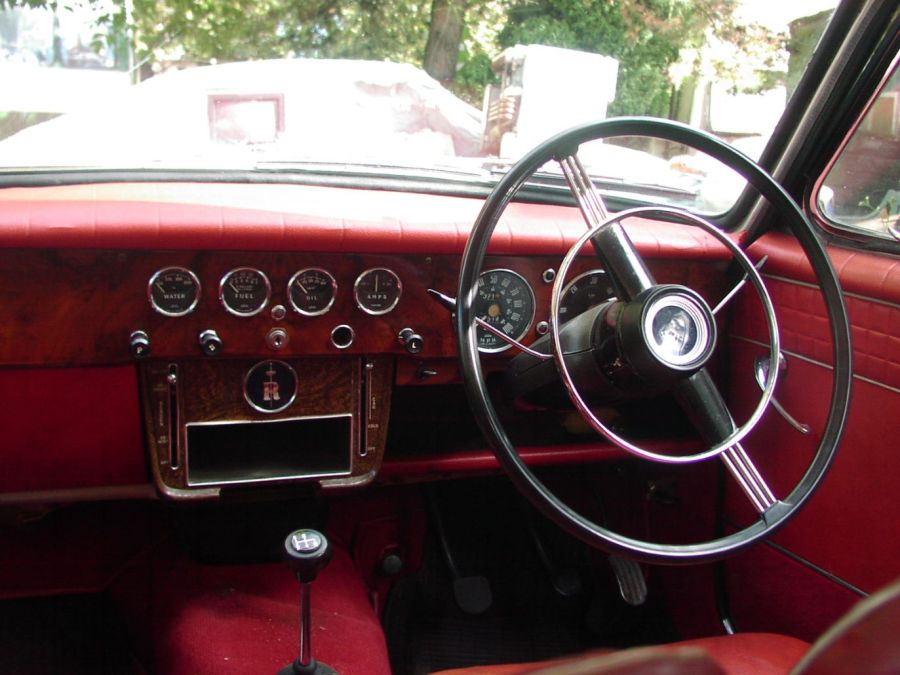
1961
The Series IIIA Rapier features upgraded drivetrain for better durability- 1592cc engine with larger-diameter crank bearings, stiffer crankshaft, larger piston gudgeon pins, uprated oil and water pumps. 1494cc engine now makes 78bhp. Stronger front anti-roll bar improves roadholding. Fresh-air heater now standard.
1963
Rapier convertible discontinued in the summer. In the autumn the Series IV Rapier is announced, with numerous mechanical upgrades introduced across the ‘Audax’ range at this point, including ‘sealed for life’ greaseless suspension and steering parts. Brake servo is now standard and springs and dampers adjusted to give a more saloon-like ride. Wheels go from 15- to 13-inches and generic Rootes wheel trims are fitted instead of bespoke Rapier ones. Front end restyled with flatter, lower-set bonnet, orange indicators incorporated into the side grilles and a smaller, convex grille fitted. Dashboard now incorporates a proper glovebox, allowing for a parcel shelf below, and a centre console is fitted.
1964
All ‘Audax’ cars, including the Rapier, receive a new all-synchro gearbox.
1965
The Series V Rapier has a five-bearing 1725cc engine, developing 91bhp. An alternator is standard equipment and the electrical system switches to negative earth.
1967
Sunbeam Rapier production ends in June, after 68,809 were built.

